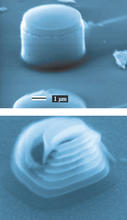Building 1 Extension (B1E)—Enabling Sustained Scientific Advancement and Innovation
(+$28 million)
Challenge

When President Eisenhower dedicated the NIST facilities in Colorado in 1954, no one imagined that half a century later scientists would be manipulating matter atom-by-atom. Such technological advances require increasingly complex and difficult measurements—to be able to observe, characterize, and create structures at ever smaller spatial scales. As the structures shrink in size, small fluctuations in temperature, humidity, air quality, and vibration begin to distort the results. Laboratory conditions have now reached the point that they are inhibiting further advances in some of the most promising areas of research for the 21st century.
As the nation's premier measurement agency, NIST must be able to produce extremely accurate data for industry and academia to maintain confidence in its results and intercomparisons. Improvement in environmental conditions within NIST's Boulder, Colo., research laboratories is required to make further progress in measurements related to high frequency electronics, advanced materials characterized at the atomic level, sub-cellular forces, timing accuracy, and other areas.
Proposed NIST Program
The $28 million proposed in the FY 2008 budget will leverage previously proposed funds ($10.1 million) in the FY 2007 budget to construct state-of-the-art laboratory space that will meet the stringent environmental conditions required for 21st-century scientific advances. An additional $38.1 million will be needed in FY 2009 to complete the project. With a total cost of $76.2 million, the Building 1 Extension is the most cost-effective approach to enabling world-class measurement science in support of some of the country's most important economic sectors.
Expected Impacts
Construction of the B1E will dramatically enhance NIST's measurement capability and will directly support the needs of industry and academia. Some of the anticipated impacts include the ability to:
- Make frequency measurements above 100 GHz, which are required for advanced commercial electronics, military systems, and homeland security;
- Measure and perform research on materials properties at the single atom level;
- Measure cellular and sub-cellular forces below 10-12 newtons to understand the inner workings of cells and to apply this measurement capability to other physical systems; and
- Make timing measurements with uncertainties reduced to one part in 10-18, enabling whole new generations of position, navigation, and guidance systems.

